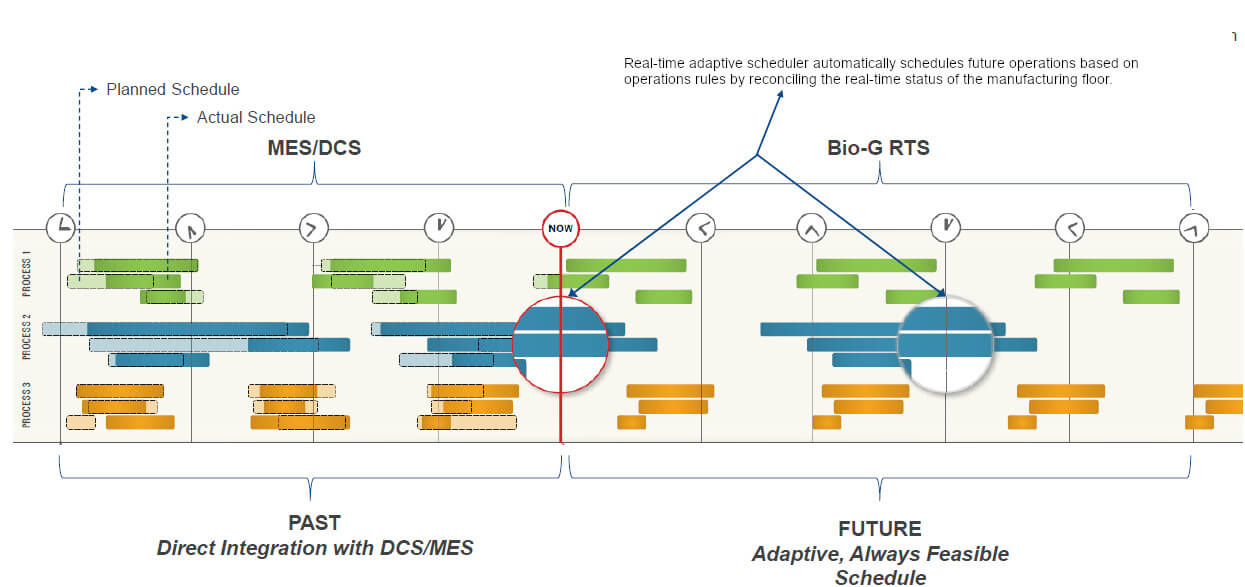Pharmaceutical & Biopharmaceutical manufacturers face the continued challenge of how to achieve maximum capacity in their facilities. Often a facility does not achieve maximum design capacity due to hidden operational bottlenecks. One way to drive performance gains is to identify the causes behind this situation and operate as close to design specifications as is possible.
At the Biomanufacturing World Summit, Emerson’s Ron Rossbach presented on using digitalization and data integration to help drive operational efficiency. A key enabling technology for these performance gains is in real-time adaptive scheduling. This technology combines finite scheduling with dynamic updates from existing shop-floor execution systems to optimize operations. In 2018 Emerson acquired BioG, the leading provider of adaptive scheduling software, which is now being adopted across the industry.
Ron opened his presentation highlighting the pressures these Life Sciences manufacturers face in reducing time to market for their products, increasing productivity in capital projects, reducing ongoing costs of quality, and improving operational agility in forecasting and decision-making. Ron also described the growing use of the BioPhorum Digital Plant Maturity Model.
BioPhorum defines 5 levels of digital maturity—pre-digital plant, digital silos, connected plant, predictive plant, and adaptive plant. Ron noted that most biopharmaceutical producers are somewhere between level 2: digital silos and level 3: connected plant.
To reap the benefits of digitalization and improved work practices, a key leap is expanding the vertical integration of systems such as enterprise resource planning (ERP), laboratory execution systems (LES), and shop-floor systems such as manufacturing execution systems (MES) and process automation & control systems.
The foundation of Emerson’s approach to adaptive scheduling is a model that reflects the true constraints of the facility, both from an equipment and operating principle perspective. This model, which encompasses the required resources and timing, enables the prediction of an accurate, feasible schedule. This ensures that a scheduler won’t make a production schedule that cannot be achieved and will adjust the schedule as issues emerge during production run.
When describing how the adaptive technology works, Ron used the analogy of Google Maps. Google Maps plots an initial route for you to follow, but when you make a wrong turn it recalculates your new route on the fly without leaving you to figure it out. Other schedulers try to get you back to the original route instead of adaptively figuring out the best new path.
Maintenance downtime can also be minimized, by automatically scheduling maintenance tasks to take advantage of periods where equipment is not being used per the current production schedule. When coupled with predictive analytics to optimize which maintenance tasks to perform, a facility can optimize both “when” to do maintenance and “what” tasks to perform.
Ron shared a story with me of a biotech facility that sought to operate at their maximum run rate. They needed a tool for calculating capacity, debottlenecking, and better managing the schedules of hundreds of activities required in a production run.
Using the real-time adaptive scheduler, they modeled the process to calculate maximum run rates, perform capacity analysis and “what if” testing on ways to drive greater operational performance. Once this adaptive scheduler was operational, it provided real-time schedule updates, data reconciliation, and enabled white space analysis for additional production opportunities.
Manhours were reduced by over 90% going from manual scheduling to adaptive scheduling. Maintenance activities were also much better coordinated with activities scheduled during white spaces and automatically rescheduled in the event of production delays. Overall, this biotech facility was able to ramp up to maximum run rate and sustain it over time.
Visit Emerson’s real-time adaptive scheduling software web pages for more on how this technology can drive operational improvements and greater flexibility for Life Sciences facilities. You can also connect and interact with other pharmaceutical and biotech industry experts in the Life Sciences group in the Emerson Exchange 365 community.


